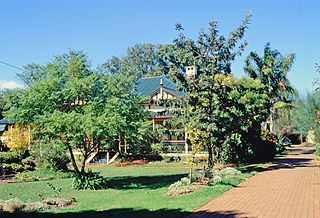
Elphin is a heritage-listed villa at 24 Anzac Avenue, Newtown, Toowoomba, Toowoomba Region, Queensland, Australia. It was designed by William Hodgen and built in 1907. It was added to the Queensland Heritage Register on 28 July 2000.
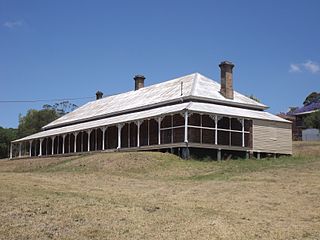
Harlaxton House is a heritage-listed villa at 6 Munro Street, Harlaxton, Queensland, Australia. It was built from 1869 to 1870 to 1910s circa. It was added to the Queensland Heritage Register on 21 October 1992.

Oak Lodge and Spreydon is a heritage-listed pair of villas at 7 Warra Street & 30 Rome Street, Newtown, Toowoomba, Toowoomba Region, Queensland, Australia. They were designed by architectural firm James Marks and Son and was built from 1890s to c. 1923. They were added to the Queensland Heritage Register on 1 October 2003.
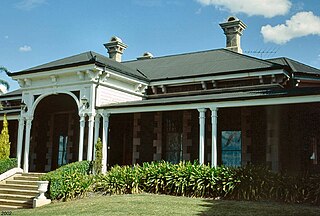
Smithfield House is a heritage-listed villa at 8 Panda Street, Harristown, Toowoomba, Toowoomba Region, Queensland, Australia. It was designed by architectural firm James Marks and Son and built from c. 1895 onwards. It was added to the Queensland Heritage Register on 21 October 1992.
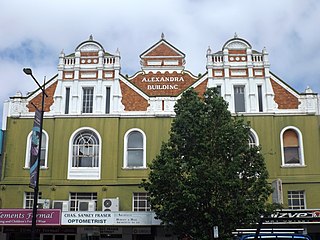
Alexandra Building is a heritage-listed commercial building at 451-455 Ruthven Street, Toowoomba, Queensland, Australia. It was designed by Toowoomba architect Henry James (Harry) Marks and built in 1902 by James Renwick. It was added to the Queensland Heritage Register on 16 October 2008.

Bishop's House is a heritage-listed villa at 73 Margaret Street, East Toowoomba, Toowoomba, Toowoomba Region, Queensland, Australia. It was designed by Henry Marks and built from 1910 to c. 1911 and from 1939 to c. 1940. It is also known as Dalmally and Kilallah. It was added to the Queensland Heritage Register on 21 October 1992.

Clifford House is a heritage-listed club house at 120 Russell Street, Toowoomba, Toowoomba Region, Queensland, Australia. It was built c. 1865. It was added to the Queensland Heritage Register on 21 October 1992.

The Exchange Building is a heritage-listed commercial building at 245-253 Margaret Street, Toowoomba City, Toowoomba, Toowoomba Region, Queensland, Australia. It consists of two storeys, with a row of four shops on the first floor with office space above. It was built by 1905, and designed by Toowoomba architect Harry Marks. It was added to the Queensland Heritage Register on 27 October 2000, and is considered significant for its aesthetic contribution to the streetscape of Margaret Street, for its status as surviving evidence of the early development of the commercial centre of Toowoomba, and for its association with Marks. As of February 2013, it was tenanted by a number of shops facing Margaret Street, with offices on the second floor.

Gabbinbar is a heritage-listed villa at 344-376 Ramsay Street, Toowoomba, Middle Ridge, Toowoomba Region, Queensland, Australia. It was designed by architect Willoughby Powell for the Rev. Dr. William Lambie Nelson and built in 1876 by Richard Godsall. It was added to the Queensland Heritage Register on 21 October 1992.

Gladstone House and Cottage is a heritage-listed detached house at 1B-3 Gladstone Street, Newtown, Toowoomba, Toowoomba Region, Queensland, Australia. It was designed by Harry Marks for himself and built c. 1908. It is also known as St Rest. It was added to the Queensland Heritage Register on 13 January 1995.

Glen Alpine is a heritage-listed villa at 32-36 East Street, Redwood, Toowoomba, Toowoomba Region, Queensland, Australia. It was designed by Toowoomba architect Harry Marks and built c. 1918. It was added to the Queensland Heritage Register on 11 June 1993.

Kensington is a heritage-listed villa at 126 Russell Street, Toowoomba, Toowoomba Region, Queensland, Australia. It was designed by William Hodgen Junior and built in 1897. It was added to the Queensland Heritage Register on 28 July 2000.

Rodway is a heritage-listed villa at 2 South Street, Rangeville, Toowoomba, Toowoomba Region, Queensland, Australia. The architect was Harry Marks. It was built from c. 1904 to 1930s. It is also known as Sylvia Park. It was added to the Queensland Heritage Register on 21 October 1992.

Soldiers Memorial Hall is a heritage-listed memorial at 149 Herries Street, Toowoomba City, Queensland, Australia. It was designed by Hodgen & Hodgen (Toowoomba) and built from 1923 to 1959 by Smith Bros (Toowoomba). It was added to the Queensland Heritage Register on 17 December 1999.
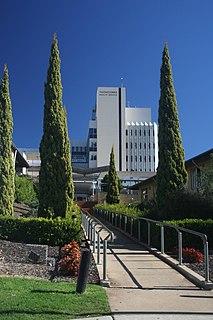
Toowoomba Hospital is a heritage-listed hospital at Pechey Street, Toowoomba, Toowoomba Region, Queensland, Australia. It was built from c. 1880 to c. 1927. It is also known as Toowoomba Base Hospital. It was added to the Queensland Heritage Register on 28 July 2000.

Tor is a heritage-listed villa at 396 Tor Street, Newtown, Toowoomba, Toowoomba Region, Queensland, Australia. It was designed by William Hodgen and built in 1904. It was added to the Queensland Heritage Register on 28 May 1999.
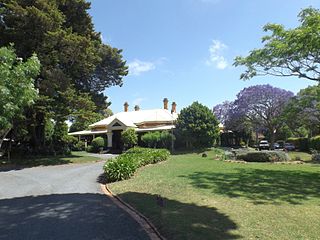
Vacy Hall is a heritage-listed villa at 135 Russell Street, Toowoomba, Toowoomba Region, Queensland, Australia. It was built c. 1899. It was added to the Queensland Heritage Register on 21 October 1992.

The White Horse Hotel is a heritage-listed former hotel at 456 Ruthven Street, Toowoomba, Queensland, Australia. A hotel known as the White Horse Hotel is known to have existed since 1866. The current two-storey building was built in stages, with much of the current fabric dating from renovations c. 1912, which included a new facade and the remodelling of both wings. The verandah overlooking Ruthven Street had been removed by 1978, and an additional room was built about this time.

Wislet is a heritage-listed detached house and former hospital at 127 Russell Street, Toowoomba, Toowoomba Region, Queensland, Australia. It was designed by William Hodgen junior and was built in 1908 for Dr Freidrich Hinrichsen and his wife, Dori, in 1908, as a large two-story building combining a residence and medical suite. It was thereafter sold to two other Toowoomba doctors: Thomas Connolly in 1910, who renamed the property Drynane, and John Hulme in 1948.

Hotel Corones is a heritage-listed hotel at 33 Wills Street, Charleville, Shire of Murweh, Queensland, Australia. It was designed by William Hodgen junior and built from 1924 to 1929 by day labour. It is also known as Corones Hotel Norman. It was added to the Queensland Heritage Register on 1 July 1997.
























